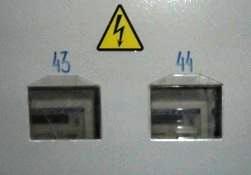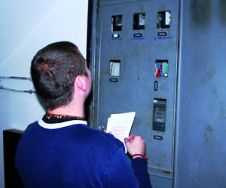Categories: Featured Articles » Controversial issues
Number of views: 49395
Comments on the article: 10
Multitariff electric meter. When will the costs pay off?
 Multi-tariff meters are becoming more common when accounting consumption electricity. How quickly will the costs of its acquisition and installation pay off?
Multi-tariff meters are becoming more common when accounting consumption electricity. How quickly will the costs of its acquisition and installation pay off?
The economic effect of the application seems obvious. multitariff metering devices for electric energy. The essence of the work of this electric meter is that, depending on the program laid down in it, it takes into account the energy consumption not by one digit, but by several. The total amount of electrical energy consumed by the consumer is divided into two time intervals: day and night.
The tariff for electricity consumed during the daytime is normal, set by the regional energy commissions. But the electricity “burned” at night costs exactly half the price!
The fact is that energy companies, trying to more evenly distribute the load on their equipment and electric networks, decided to interest electricity consumers in reducing consumption in the daytime and increasing in the night.
Of course, that interest is always determined by monetary amounts, which at the end of the month the consumer must transfer to the accounts of power engineers. It was on this basis that the so-called time-differentiated tariffs arose. As a rule, when using a differentiated tariff, daily electricity consumption is calculated from seven to twenty-three hours, and nightly - from twenty-three to seven.
Now, having understood in general terms the picture, we can go directly to calculating the economic efficiency of using a multi-tariff meter.
Let's start with the electric meter itself. Now the range of these devices in the consumer market is very wide. Accordingly, the wide range of prices for them: from one thousand two hundred rubles, to three or more. This is due, as you might guess, to the quality and reliability of the device. For our reasoning, let’s take the average price, say, at the price of one thousand five hundred rubles. We purchased the counter.
Next, walks begin at instances, that is, at energy retail companies. In principle, people do not work there badly and it doesn’t take much time to process applications and transfer to use a differentiated tariff (provided that on the day we go to draw up our desire to pay less at night, those wishing to arrange something in this kind will not be too much).
The next step is the installation of a multi-tariff electric meter. This work can be performed by employees of the sales company, as well as by any third-party organization or commercial structure specializing in this type of work. The price of this service also ranges from three hundred and fifty to one and a half thousand rubles. Again, we proceed from the average cost - nine hundred rubles.
Now you need to program the meter so that it correctly takes into account the energy consumption in the daytime and at night. Programming is also not a free service and you will have to pay eight hundred rubles for it (again at an average price).
Well, that’s almost it. Remains only seal electric meter for two hundred rubles, and you can start saving money at night. All costs for the meter will be three thousand four hundred rubles.
 What usually works after twenty-three hours in our homes? Surely the first thing that everyone will call is TV. The average power consumption of this device is one hundred and fifty watts per hour. How much time do we watch TV at night? The average Russian is sitting at the screen until one in the morning.
What usually works after twenty-three hours in our homes? Surely the first thing that everyone will call is TV. The average power consumption of this device is one hundred and fifty watts per hour. How much time do we watch TV at night? The average Russian is sitting at the screen until one in the morning.
We do not take into account those who lead a nocturnal lifestyle. Yes, and they often "freeze" in nightclubs than blue screens.And the average person watches TV at night for two hours. So it “burns” three hundred watts per day. Multiply by thirty days and get four and a half kilowatts.
Also, of course, at night we use lighting. We will assume that all the time while we are watching TV, we have a three-arm chandelier with bulbs of one hundred watts each (we don’t take into account that you may have energy-saving bulbs, the use of which the leadership of the country never ceases to remind us of). We multiply, add and get nine kilowatts per month.
The refrigerator also has the ability to turn on, including at night. The power consumption of modern units does not exceed two hundred watts per hour. But the author has not yet met a refrigerator that would work for so long without turning off. Well, okay, we’ll consider that the machine produces cold five hours a night (during the day we will disconnect it from the network in order to save!). Total thirty kilowatts per month.
Suppose we program our washing machine at night. How often do we wash five to six times a month? Let it be ten! We assume that for work we choose the longest washing cycle - two and a half hours. During this time, even when the water is heated to a maximum temperature, the flow rate will not exceed four kilowatts. This is another forty kilowatts per month.
Add to the various little things, such as telephones, radios, and so on, another five kilowatts per month. After summing and rounding, we get the flow rate at night of the order of eighty-five kilowatts.
On average, in Russia, one kilowatt of electricity costs three rubles. Let's not forget that using electricity at night we save half. We multiply one ruble of fifty kopecks by eighty-five kilowatts and we get that in a month we saved one hundred twenty-seven rubles and fifty kopecks.
Now we will divide our costs into everything connected with the meter by the saved amount and find out that under such conditions the costs will be justified in twenty-six months.
The picture will certainly change if you use electric heating, which actively consumes electricity around the clock. Then the benefits will be noticeable. But, to complete the picture, I would like to give one more interesting fact.
In two thousand and two, the second or third year, the energy commissions of some regions (from the supply of power engineers, of course) approved tariffs in which consumers with multi-tariff meters were almost equal to other consumers due to the fact that their daily tariff was slightly higher than usual and the night tariff was seventy percent of undifferentiated by time of day. This cannot be ruled out in the future, when energy companies consider lost profits from the use of multitariff metering devices by the population.
See also at bgv.electricianexp.com
:
